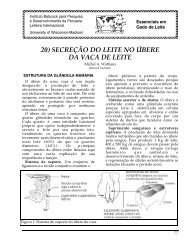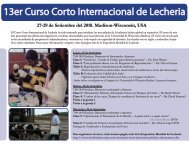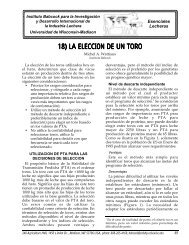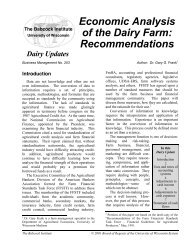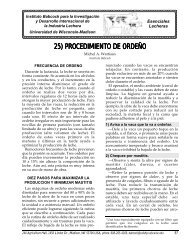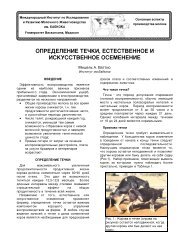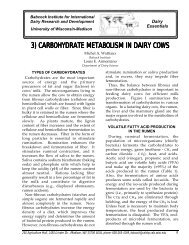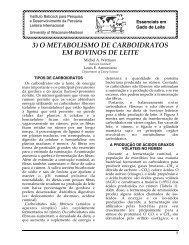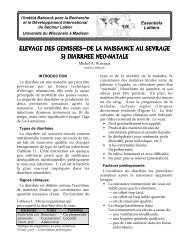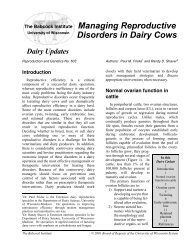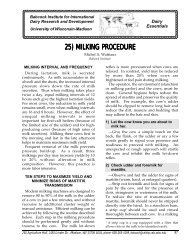crianza de terneras—del nacimiento al destete ... - Babcock Institute
crianza de terneras—del nacimiento al destete ... - Babcock Institute
crianza de terneras—del nacimiento al destete ... - Babcock Institute
Create successful ePaper yourself
Turn your PDF publications into a flip-book with our unique Google optimized e-Paper software.
Instituto <strong>Babcock</strong> para la Investigación<br />
y Desarrollo Internacion<strong>al</strong> <strong>de</strong><br />
la Industria Lechera<br />
Universidad <strong>de</strong> Wisconsin-Madison<br />
Esenci<strong>al</strong>es<br />
Lecheras<br />
CRIANZA DE TERNERAS—DEL NACIMIENTO AL DESTETE<br />
30) ALIMENTANDO HENO, CONCENTRADOS Y AGUA<br />
Michel A. Wattiaux<br />
Instituto <strong>Babcock</strong><br />
INTRODUCCION DE COMIDA SOLIDA<br />
EN LA DIETA<br />
Las terneras jóvenes y recién nacidas son<br />
<strong>al</strong>imentadas princip<strong>al</strong>mente con dietas<br />
líquidas ya que no trabajan como rumiantes<br />
por que solo tienen un estómago funcion<strong>al</strong>,<br />
el abomaso. Cuando la ternera es<br />
<strong>al</strong>imentada con leche o con substituto <strong>de</strong><br />
leche, el hecho <strong>de</strong> que se cierre la<br />
escotadura esofágica hace que la leche<br />
sobrepase el retículo-rumen y fluya<br />
directamente hacia el abomaso. Sin<br />
embargo, cuando se ingieren <strong>al</strong>imentos<br />
sólidos, la escotadura esofágica<br />
gradu<strong>al</strong>mente cesa su función, una<br />
población bacteriana se establece en el<br />
rumen, y comienza el <strong>de</strong>sarrollo <strong>de</strong> la pared<br />
Ternera prerumiante <strong>al</strong> <strong>nacimiento</strong><br />
Hacia los<br />
intestinos<br />
Rumen<br />
25%<br />
Abomaso<br />
60%<br />
Esófago<br />
Omaso<br />
10%<br />
• El rumen está sub<strong>de</strong>sarrollado y<br />
no es funcion<strong>al</strong>; la leche sobrepasa<br />
el rumen y es digerida en el abomaso<br />
y el los intestinos<br />
Retículo<br />
5%<br />
Figura 1: Etapas en el <strong>de</strong>sarrollo rumin<strong>al</strong><br />
rumin<strong>al</strong>. Eventu<strong>al</strong>mente, las novillas se<br />
tornan capaces <strong>de</strong> utilizar <strong>al</strong>imentos<br />
fibrosos ya que los microbios viven y crecen<br />
en el rumen.<br />
Uno pue<strong>de</strong> <strong>de</strong>cir que el rumen se ha<br />
vuelto funcion<strong>al</strong> cuando una ternera joven<br />
comienza a masticar su bolo <strong>al</strong>imenticio a<br />
los dos o cuatro meses <strong>de</strong> edad.<br />
Por lo que la disponibilidad e ingestión<br />
temprana <strong>de</strong> <strong>al</strong>imento sólido permite un<br />
rápido <strong>de</strong>sarrollo rumin<strong>al</strong> y un <strong>de</strong>stete<br />
temprano (<strong>de</strong> cinco a ocho semanas <strong>de</strong><br />
edad).<br />
Desarrollo rumin<strong>al</strong><br />
Una ternera no <strong>de</strong>be <strong>de</strong> ser <strong>de</strong>stetada<br />
hasta que su rumen sea funcion<strong>al</strong> y capaz<br />
<strong>de</strong> soportar sus necesida<strong>de</strong>s nutricion<strong>al</strong>es.<br />
• Consumo <strong>de</strong> <strong>al</strong>imento seco,<br />
especi<strong>al</strong>mente grano o una mezcla<br />
<strong>de</strong> concentrados (iniciador) que<br />
estimula el crecimiento rumin<strong>al</strong><br />
Novilla <strong>de</strong>spués <strong>de</strong>l <strong>de</strong>stete<br />
Rumen<br />
80%<br />
Abomaso<br />
7%<br />
Omaso<br />
8%<br />
Retículo<br />
5%<br />
• La ternera rumia y obtiene<br />
la mayoría <strong>de</strong> su energía<br />
y proteína <strong>de</strong> la fermentación<br />
rumin<strong>al</strong><br />
240 Agriculture H<strong>al</strong>l, 1450 Lin<strong>de</strong>n Dr., Madison, WI 53706 USA, phone: 608-265-4169, babcock@c<strong>al</strong>shp.c<strong>al</strong>s.wisc.edu 117
Esenci<strong>al</strong>es Lecheras: Crianza <strong>de</strong> terneras y novillas<br />
Los productos fin<strong>al</strong>es <strong>de</strong> la fermentación<br />
rumin<strong>al</strong> (ácidos grasos volátiles) proveen el<br />
estímulo necesario para el <strong>de</strong>sarrollo <strong>de</strong>l<br />
rumen. Sin embargo, cuando a estas se les<br />
niega el acceso a <strong>al</strong>imento sólido, el rumen<br />
permanecerá sub<strong>de</strong>sarrollado. El rumen <strong>de</strong><br />
las terneras que no tienen acceso a <strong>al</strong>imento<br />
sólido permanecerá sin <strong>de</strong>sarrollo. Esta<br />
técnica es utilizada para producir terneras<br />
blancas para carne. Por lo que el consumo<br />
<strong>de</strong> <strong>al</strong>imento seco es crítico para el<br />
<strong>de</strong>sarrollo rumin<strong>al</strong>. Las bacterias,<br />
protozoarios y hongos que son habitantes<br />
norm<strong>al</strong>es <strong>de</strong>l rumen, son establecidos<br />
natur<strong>al</strong>mente cuando la ternera consume<br />
<strong>al</strong>imentos sólidos ya que cientos <strong>de</strong> especies<br />
<strong>de</strong> microorganismos entran <strong>al</strong> rumen<br />
unidos a las partículas <strong>de</strong> <strong>al</strong>imento, sin<br />
embargo, la población en el rumen es<br />
dominada únicamente por unas cuantas<br />
especies microbianas. Las bacterias que<br />
prosperan en el rumen son aquéllas capaces<br />
<strong>de</strong> fermentar carbohidratos en ausencia <strong>de</strong><br />
oxígeno (bacterias anaeróbicas). Los<br />
productos fin<strong>al</strong>es <strong>de</strong> la fermentación <strong>de</strong><br />
carbohidratos (acetato y butirato en<br />
particular) son importantes promotores <strong>de</strong>l<br />
crecimiento y <strong>de</strong>sarrollo rumin<strong>al</strong>, por lo<br />
que este <strong>de</strong>pen<strong>de</strong> más <strong>de</strong>l consumo <strong>de</strong><br />
grano que <strong>de</strong>l <strong>de</strong> forraje. El consumo<br />
temprano <strong>de</strong> un iniciador <strong>al</strong>tamente<br />
p<strong>al</strong>atable (granos o mezcla <strong>de</strong><br />
concentrados) es importante para asegurar<br />
un rápido <strong>de</strong>sarrollo rumin<strong>al</strong> y una buena<br />
transición <strong>al</strong> momento <strong>de</strong>l <strong>de</strong>stete.<br />
Tabla 1: Ejemplo <strong>de</strong> la composición <strong>de</strong> una mezcla <strong>de</strong> concentrados para terneras jóvenes<br />
INICIADOR EN GRANO 1<br />
INICIADOR COMPLETO 2<br />
INGREDIENTES 1 2 3 4 1 2 3 4<br />
..................................... CANTIDAD (kg como es) ..................................<br />
Alf<strong>al</strong>fa en pellets -- -- -- -- 18.9 17.0 18.8 16.0<br />
Maíz en grano 35.0 30.0 50.0 50.0 24.0 22.0 -- 15.0<br />
Maíz (grano + marlo) -- -- -- -- -- 22.0 35.0 10.0<br />
Avena 35.0 13.0 -- -- 35.0 -- 22.0 10.0<br />
Germen <strong>de</strong> trigo -- 10.0 10.0 -- -- -- -- --<br />
Pulpa <strong>de</strong> remolacha -- -- -- -- -- 15.0 -- 10.0<br />
Gluten <strong>de</strong> maíz -- -- -- 20.0 -- -- -- 10.0<br />
Granos <strong>de</strong> <strong>de</strong>stilería -- -- 10.0 -- -- -- -- 10.0<br />
Linaza 10.0 10.0 10.0 -- -- -- --<br />
Suplemento con 44% PC 22.7 10.0 12.8 12.9 15.0 17.0 17.0 12.0<br />
Suero <strong>de</strong>shidratado -- 10.0 -- -- -- -- -- --<br />
Melaza 5.0 5.0 5.0 5.0 5.0 5.0 5.0 5.0<br />
Miner<strong>al</strong>es, 23% Ca y 18% P 0.6 -- -- -- 1.1 1.2 1.2 1.0<br />
Piedra c<strong>al</strong>iza o CaC03 1.4 1.7 1.9 1.8 0.7 0.5 0.7 0.7<br />
Premezcla <strong>de</strong> miner<strong>al</strong>es traza 0.25 0.25 0.25 0.25 0.3 0.3 0.3 0.3<br />
Tot<strong>al</strong> 100.0 100.0 100.0 100.0 100.0 100.0 100.0 100.0<br />
NUTRIENTES<br />
Energía<br />
........................... COMPOSICION (Base <strong>de</strong> materia seca) ....................<br />
TND 3 , % 80.3 79.5 81.8 82.7 75.6 76.1 75.1 77.4<br />
Energía neta <strong>de</strong> mant., Mc<strong>al</strong>/kg 1.96 1.94 2.00 2.02 1.80 1.83 1.80 1.87<br />
Energía neta <strong>de</strong> crec., Mc<strong>al</strong>/kg 1.32 1.30 1.36 1.39 1.19 1.21 1.19 1.23<br />
Proteína cruda, % 19.9 19.6 20.2 20.7 18.4 18.5 18.5 19.4<br />
Fibra ácido <strong>de</strong>tergente, % 8.6 8.3 7.6 6.7 14.2 16.6 15.4 16.1<br />
Fibra neutro <strong>de</strong>tergente, % 18.0 20.4 18.6 17.6 24.3 27.6 26.2 30.1<br />
C<strong>al</strong>cio, % 0.89 0.95 0.94 0.95 0.82 0.84 0.85 0.85<br />
Fósforo, % 0.51 0.59 0.52 0.51 0.51 0.51 0.52 0.52<br />
Miner<strong>al</strong>es traza, % 0.28 0.28 0.28 0.28 0.34 0.34 0.34 0.34<br />
1<br />
El iniciador en grano pue<strong>de</strong> ser <strong>al</strong>imentado con forraje como heno <strong>de</strong> buena c<strong>al</strong>idad<br />
2<br />
El iniciador completo pue<strong>de</strong> ser <strong>al</strong>imentado únicamente ya que incluye los niveles a<strong>de</strong>cuados <strong>de</strong> fibra<br />
3<br />
TND = Tot<strong>al</strong> <strong>de</strong> Nutrientes Digestibles = % proteína cruda digestible + % fibra cruda digestible + %<br />
extracto libre <strong>de</strong> nitrógeno digestible + (2.25 x % extracto etéreo digestible).<br />
118 Instituto <strong>Babcock</strong>
¿Cuándo se <strong>de</strong>be <strong>de</strong> comenzar a<br />
ofrecer el iniciador?<br />
El iniciador en forma <strong>de</strong> grano <strong>de</strong>be <strong>de</strong> ser<br />
ofrecido tempranamente, comenzando a los<br />
4 días <strong>de</strong>spués <strong>de</strong>l <strong>nacimiento</strong> y <strong>de</strong>be<br />
continuar hasta los 4 meses <strong>de</strong> edad, 6 a 8<br />
semanas <strong>de</strong>spués <strong>de</strong>l <strong>de</strong>stete. La ternera<br />
comerá cantida<strong>de</strong>s muy pequeñas <strong>de</strong><br />
<strong>al</strong>imentos sólidos las primeras dos semanas<br />
<strong>de</strong>spués <strong>de</strong>l <strong>nacimiento</strong>. Sin embargo, se les<br />
<strong>de</strong>be <strong>de</strong> fomentar a comer iniciador. Por<br />
ejemplo:<br />
• El iniciador <strong>de</strong>be <strong>de</strong> incluir melaza u<br />
otros ingredientes p<strong>al</strong>atables;<br />
• El iniciador <strong>de</strong>be <strong>de</strong> ser ofrecido<br />
frecuentemente, pero en cantida<strong>de</strong>s<br />
pequeñas para mantenerlo fresco;<br />
• El consumo <strong>de</strong> leche <strong>de</strong>be <strong>de</strong> ser<br />
limitado a un máximo <strong>de</strong> 10% <strong>de</strong>l peso<br />
corpor<strong>al</strong> <strong>al</strong> <strong>nacimiento</strong> por día;<br />
• Agua limpia y fresca <strong>de</strong>be <strong>de</strong> estar<br />
disponible tan pronto como el iniciador<br />
en grano es ofrecido. El consumo<br />
<strong>de</strong> <strong>al</strong>imento seco se mejora cuando se<br />
incrementa el consumo <strong>de</strong> agua;<br />
• Una mano llena <strong>de</strong> iniciador pue<strong>de</strong> ser<br />
puesta en el morro <strong>de</strong> la ternera o en el<br />
fondo <strong>de</strong> la cubeta inmediatamente<br />
<strong>de</strong>spués <strong>de</strong> que esta terminó <strong>de</strong> beber<br />
la leche;<br />
• Los iniciadores pue<strong>de</strong>n ser<br />
<strong>al</strong>imentados con una botella con<br />
chupón para fomentar el consumo.<br />
¿Se <strong>de</strong>be <strong>de</strong> <strong>al</strong>imentar con heno y<br />
concentrado?<br />
Investigaciones tempranas sugerían que<br />
una mezcla <strong>de</strong> concentrado y heno <strong>de</strong><br />
buena c<strong>al</strong>idad era necesario para un<br />
<strong>de</strong>sarrollo norm<strong>al</strong> <strong>de</strong>l rumen. El <strong>al</strong>imento<br />
fibroso y voluminoso se pensaba que<br />
jugaba un papel muy importante en el<br />
incremento <strong>de</strong> la capacidad rumin<strong>al</strong>, así<br />
como en el mantenimiento y forma norm<strong>al</strong><br />
<strong>de</strong> las papilas. Sin embargo,<br />
investigaciones más recientes han<br />
<strong>de</strong>mostrado que no existe una ventaja en<br />
<strong>al</strong>imentar heno cuando el iniciador está<br />
formulado para contener cantida<strong>de</strong>s<br />
suficientes <strong>de</strong> fibra. En contraste, los<br />
30 - Alimentando heno, concentrados y agua<br />
carbohidratos en el concentrado son<br />
esenci<strong>al</strong>es ya que ellos proveen <strong>de</strong> ácido<br />
butírico y ácido acético que son requeridos<br />
para el crecimiento y el <strong>de</strong>sarrollo <strong>de</strong> la<br />
pared rumin<strong>al</strong>. Si el iniciador no contiene<br />
por lo menos 25% <strong>de</strong> fibra neutro<br />
<strong>de</strong>tergente (FND), heno pue<strong>de</strong> ser provisto.<br />
Adicion<strong>al</strong>mente, el iniciador <strong>de</strong>be <strong>de</strong><br />
contener <strong>al</strong>re<strong>de</strong>dor <strong>de</strong> 18% <strong>de</strong> proteína<br />
cruda, 75 a 80% <strong>de</strong> TND y <strong>de</strong>be <strong>de</strong> ser<br />
fortificado con vitaminas A, D y E.<br />
Existen dos tipos <strong>de</strong> iniciadores: los<br />
iniciadores en grano y los iniciadores<br />
completos (Tabla 1) Los iniciadores<br />
completos contienen un nivel más <strong>al</strong>to <strong>de</strong><br />
fibra (menos energía) que un iniciador en<br />
grano, pero ambos pue<strong>de</strong>n ser formulados<br />
con ingredientes que se utilizan para<br />
<strong>al</strong>imentar un anim<strong>al</strong> adulto (excepto urea).<br />
Un iniciador completo es más factible que<br />
sea menos p<strong>al</strong>atable y que se ingiera en<br />
cantida<strong>de</strong>s más pequeñas que un iniciador<br />
Peso corpor<strong>al</strong> (kg)<br />
90<br />
40<br />
0 2 4 6 8 10 12<br />
Edad (semanas)<br />
Universidad <strong>de</strong> Wisconsin-Madison 119<br />
80<br />
70<br />
60<br />
50<br />
Consumo <strong>de</strong> iniciador (g/día)<br />
1600<br />
1400<br />
1200<br />
1000<br />
800<br />
600<br />
400<br />
200<br />
Consumo <strong>de</strong> leche 3.6 kg/día<br />
0<br />
0 2 4 6 8 10 12<br />
Edad (semanas)<br />
Figura 2: Consumo <strong>de</strong> iniciador en grano y<br />
ganancia <strong>de</strong> peso corpor<strong>al</strong> <strong>de</strong> terneras jóvenes<br />
<strong>al</strong>imentadas con leche a una tasa constante y<br />
forraje ad libitum.
Esenci<strong>al</strong>es Lecheras: Crianza <strong>de</strong> terneras y novillas<br />
en grano. Los forrajes no son necesarios<br />
hasta <strong>de</strong>spués <strong>de</strong>l <strong>de</strong>stete cuando un<br />
iniciador completo es <strong>al</strong>imentado.<br />
Gener<strong>al</strong>mente, los granos en el iniciador<br />
están molidos burdamente o bien son<br />
rolados para obtener una textura áspera. La<br />
molienda muy fina no es recomendada, ya<br />
que las partículas finas no estimulan la<br />
rumia. La p<strong>al</strong>atabilidad a menudo es<br />
mejorada incluyendo un 5% <strong>de</strong> melaza.<br />
Cuando las terneras comen más <strong>de</strong> 1.5 a 2<br />
kg <strong>de</strong> iniciador por día (a los 3 meses <strong>de</strong><br />
edad), ellas pue<strong>de</strong>n ser <strong>al</strong>imentadas con<br />
una mezcla <strong>de</strong> concentrados más barata. La<br />
Figura 2 muestra el consumo esperado <strong>de</strong><br />
iniciador en grano cuando el forraje es<br />
administrado ad libitum comenzando a las<br />
2 semanas <strong>de</strong> edad.<br />
DESTETE<br />
El <strong>de</strong>stete <strong>de</strong>be <strong>de</strong> tomar lugar cuando la<br />
ternera esté creciendo bien y este<br />
consumiendo por lo menos el 1% <strong>de</strong> su<br />
peso corpor<strong>al</strong> en forma <strong>de</strong> iniciador (500-<br />
600 g a 700-800 g <strong>de</strong> iniciador para razas<br />
pequeñas y gran<strong>de</strong>s respectivamente). La<br />
leche <strong>de</strong>be <strong>de</strong> continuarse para terneras<br />
pequeñas o débiles. La semana antes <strong>de</strong><br />
completar el <strong>de</strong>stete, la leche pue<strong>de</strong> ser<br />
ofrecida únicamente una vez <strong>al</strong> día. La<br />
mayoría <strong>de</strong> las terneras pue<strong>de</strong>n ser<br />
<strong>de</strong>stetadas entre 5 y 8 semanas <strong>de</strong> edad. Las<br />
terneras <strong>al</strong>imentadas con iniciador en forma<br />
<strong>de</strong> grano pue<strong>de</strong>n estar listas para el <strong>de</strong>stete<br />
<strong>al</strong>gunas semanas antes que aquéllas que<br />
son <strong>al</strong>imentadas con iniciador completo.<br />
Destetar antes <strong>de</strong> 4 semanas <strong>de</strong> edad,<br />
presenta más riesgos que usu<strong>al</strong>mente<br />
conducen a una tasa <strong>de</strong> mort<strong>al</strong>idad más<br />
<strong>al</strong>ta. En contraste, <strong>de</strong>stetar <strong>de</strong>spués <strong>de</strong> las 8<br />
semanas <strong>de</strong> edad es costoso ya que:<br />
• La ración <strong>de</strong> una ternera <strong>de</strong>stetada<br />
(forraje y concentrados) es<br />
Alimentando un iniciador en grano p<strong>al</strong>atable<br />
y agua permitirán un rápido <strong>de</strong>sarrollo <strong>de</strong>l<br />
rumen así como un <strong>de</strong>stete temprano<br />
gener<strong>al</strong>mente más barata que la leche<br />
o el substituto <strong>de</strong> leche;<br />
• La tasa <strong>de</strong> crecimiento permanecerá<br />
limitada mientras las terneras sean<br />
<strong>al</strong>imentadas con una dieta líquida. La<br />
ganancia en peso gener<strong>al</strong>mente<br />
incrementa consi<strong>de</strong>rablemente<br />
<strong>de</strong>spués <strong>de</strong>l <strong>de</strong>stete y tomando en<br />
cuenta que la ternera está bien<br />
adaptada a dietas sólidas (iniciador y<br />
forrajes).<br />
Como se indicó anteriormente, las<br />
necesida<strong>de</strong>s nutricion<strong>al</strong>es <strong>de</strong> la ternera y el<br />
<strong>de</strong>sarrollo <strong>de</strong>l rumen serán mejor<br />
satisfechas con un <strong>al</strong>imento iniciador que<br />
con forraje, especi<strong>al</strong>mente antes <strong>de</strong>l <strong>de</strong>stete.<br />
Sin embargo, heno <strong>de</strong> buena c<strong>al</strong>idad o<br />
ensilaje <strong>de</strong>ben <strong>de</strong> ser <strong>al</strong>imentados <strong>de</strong>spués<br />
<strong>de</strong>l <strong>de</strong>stete. La composición <strong>de</strong> la ración<br />
<strong>de</strong>be <strong>de</strong> ser observada cuidadosamente,<br />
especi<strong>al</strong>mente cuando silo <strong>de</strong> maíz se<br />
incluye en la ración. Conforme se<br />
incrementa la capacidad <strong>de</strong> consumo<br />
<strong>de</strong>spués <strong>de</strong>l <strong>de</strong>stete, la ganancia <strong>de</strong> peso<br />
corpor<strong>al</strong> pue<strong>de</strong>, y <strong>de</strong>be, <strong>de</strong> incrementarse<br />
hacia el nivel <strong>de</strong>seado en un largo término.<br />
120 Instituto <strong>Babcock</strong>



